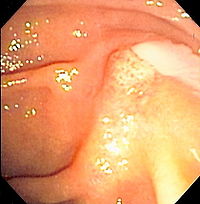
Photo from wikipedia
Introduction Cholelithiasis has a high incidence worldwide and limited treatment options due to its poorly understood pathogenesis. Furthermore, the role of biliary microbiota in cholelithiasis remains understudied. To address these… Click to show full abstract
Introduction Cholelithiasis has a high incidence worldwide and limited treatment options due to its poorly understood pathogenesis. Furthermore, the role of biliary microbiota in cholelithiasis remains understudied. To address these questions, we performed microbial sequencing from biliary samples from primary bile duct stone (PBDS) and secondary bile duct stone (SBDS) patients. Results We analyzed in total 45 biliary samples, including those from cholelithiasis patients with PBDS or SBDS and people with other digestive diseases. 16S rRNA sequencing showed the bacteria family Alcaligenaceae increased in relative abundance in the lithiasis group compared with the non-lithiasis group. In addition, the PBDS group showed significantly lower bacterial diversity than SBDS, with Propionibacteriaceae, Sphingomonadaceae, and Lactobacillaceae as the most significant bacteria families decreased in relative abundance. We further performed whole metagenomic shotgun sequencing (wMGS) and found increased ability of biofilm synthesis and the ability to sense external stimuli in PBDS based on functional annotation of mapped reads. From genome-resolved analysis of the samples, we identified 36 high-quality draft bacterial genome sequences with completion ≥70% and contamination ≤10%. Most of these genomes were classified into Proteobacteria, Firmicutes, or Actinobacteria. Conclusions Our findings indicated that there is a subtle impact on biliary microbiome from cholelithiasis while the difference is more pronounced between the PBDS and SBDS. It was revealed that the diversity of biliary microbiota in PBDS is lower, while some metabolic pathways are up-regulated, including those linked to higher incidence of different types of cancer, providing new insights for the understanding of cholelithiasis with different origin.
Journal Title: Frontiers in Cellular and Infection Microbiology
Year Published: 2022
Link to full text (if available)
Share on Social Media: Sign Up to like & get
recommendations!